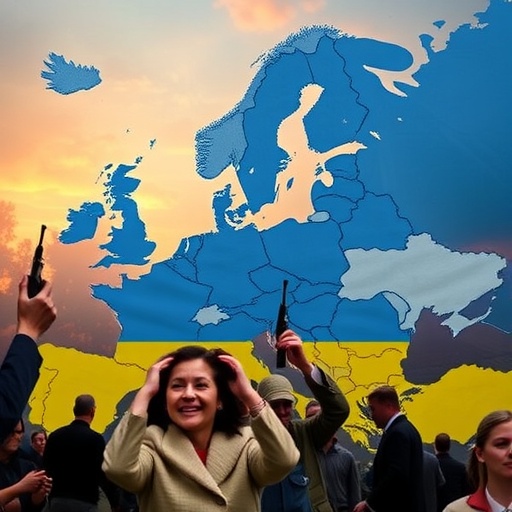Europe‘s Autonomy Under Siege: Experts Sound Alarm on Proxy Battles
In a stark warning that has reverberated across diplomatic circles, leading geopolitical analysts are cautioning that Europe is on the brink of transforming into a mere ‘geopolitical playground’ for the world’s superpowers. As the conflict in Ukraine drags into its third year, the intricate web of influences from the US, Russia, and an increasingly assertive China threatens to erode the continent’s strategic independence. This dire assessment comes amid heightened NATO deployments, Russian energy manipulations, and subtle Chinese economic inroads, painting a picture of Europe caught in a high-stakes tug-of-war.
- Europe‘s Autonomy Under Siege: Experts Sound Alarm on Proxy Battles
- Ukraine Conflict Ignites Broader European Security Crisis
- US Strategic Maneuvers Reshape European Alliances
- Russia’s Hybrid Warfare Tactics Target Europe’s Core Vulnerabilities
- China’s Quiet Inroads Complicate Europe’s Geopolitical Landscape
- Pathways to Reclaim Autonomy: Europe’s Strategic Reckoning Ahead
The phrase ‘geopolitical playground’ was first coined in a recent report by the European Council on Foreign Relations (ECFR), emphasizing how external powers are dictating the rules of engagement on European soil. ‘Europe risks becoming a passive arena where US-Russian rivalries play out, with Ukraine as the unfortunate epicenter,’ stated ECFR Director Nathalie Tocci in an exclusive interview. With over 100,000 Ukrainian casualties reported by the United Nations and billions in reconstruction costs looming, the stakes could not be higher. This isn’t just abstract diplomacy; it’s a direct challenge to Europe’s post-World War II vision of unity and self-determination.
Geopolitics in Europe has always been a delicate balance, but the invasion of Ukraine in February 2022 shattered any illusions of stability. Russia’s annexation of Crimea in 2014 was a precursor, but the full-scale war has amplified divisions. The US has poured in more than $75 billion in military aid to Ukraine, according to the Kiel Institute for the World Economy, while Russia counters with hybrid warfare tactics, including cyberattacks and disinformation campaigns targeting European elections. China, though not directly involved militarily, has deepened ties with Moscow, providing dual-use technologies that indirectly bolster Russia’s war machine.
Public sentiment in Europe reflects growing unease. A 2023 Eurobarometer survey revealed that 62% of Europeans view the Ukraine conflict as the top geopolitical threat to the continent, surpassing climate change and economic instability. This fear is compounded by energy crises, where Russia’s control over gas pipelines once supplied 40% of Europe’s needs, forcing nations like Germany to scramble for LNG alternatives from the US and Qatar.
Ukraine Conflict Ignites Broader European Security Crisis
The war in Ukraine serves as the flashpoint igniting fears of Europe becoming a geopolitical playground. What began as a localized territorial dispute has evolved into a proxy conflict drawing in global powers, with devastating consequences for European stability. Russian forces have occupied approximately 18% of Ukrainian territory, per the Institute for the Study of War, displacing over 6 million refugees into neighboring EU countries like Poland and Romania.
European leaders have responded with unprecedented unity, imposing 14 rounds of sanctions on Russia that have frozen $300 billion in Russian central bank assets. Yet, these measures have boomeranged, inflating energy prices across the continent—Germany’s inflation hit 8.7% in 2022, largely due to gas shortages. ‘Ukraine is not just fighting for its sovereignty; it’s defending Europe’s future against becoming a mere chessboard,’ Ukrainian President Volodymyr Zelenskyy declared during a virtual address to the European Parliament last month.
Military implications are profound. NATO’s eastern flank has seen a surge in troop deployments, with the US stationing 100,000 soldiers in Europe, the highest since the Cold War. Exercises like Defender Europe 2023 involved 9,000 troops from 26 nations simulating Russian incursions, underscoring the alliance’s pivot toward collective defense. However, internal fractures persist: Hungary’s Viktor Orbán has vetoed EU aid packages, citing economic burdens, while France pushes for ‘strategic autonomy’ to reduce reliance on US security guarantees.
Economically, the Ukraine war has disrupted global supply chains, with wheat exports from the Black Sea region—once 30% of the world’s total—halved due to blockades. This has led to food insecurity in Europe-dependent regions in Africa and the Middle East, potentially sparking secondary migrations that strain EU borders. Experts warn that without a swift resolution, Ukraine could become a frozen conflict, akin to Donbas pre-2022, perpetuating Europe’s vulnerability.
US Strategic Maneuvers Reshape European Alliances
The United States’ role in European geopolitics has never been more pivotal, positioning itself as the indispensable guarantor against Russian aggression while navigating tensions with China. With the US committing $61 billion in additional aid to Ukraine in April 2024, Washington is not just supporting Kyiv but reinforcing its transatlantic leadership. ‘America’s involvement in Ukraine is a litmus test for NATO’s credibility,’ noted Fiona Hill, former US National Security Council advisor, in a recent Foreign Affairs op-ed.
Yet, this support comes with strings. The US has leveraged the crisis to boost its liquefied natural gas (LNG) exports to Europe, which surged 141% in 2022 to 56 billion cubic meters, per the US Energy Information Administration. This shift has made Europe more dependent on American energy, intertwining economic and security ties. Critics argue it’s a form of soft power projection, ensuring Europe’s alignment in the broader US-China rivalry over semiconductors and critical minerals.
NATO’s expansion adds another layer. Finland and Sweden’s accession in 2023 and 2024, respectively, extended the alliance’s Baltic Sea perimeter, prompting Russia to threaten ‘military-technical responses.’ US President Joe Biden’s administration has championed this, but domestic politics loom large: with the 2024 election approaching, isolationist voices in the Republican Party question endless European commitments, echoing Donald Trump’s past criticisms of NATO ‘delinquents.’
Broader implications include cyber and space domains. The US has shared intelligence on Russian troop movements via the Five Eyes network, aiding Ukrainian strikes, while investing $10 billion in European quantum computing to counter Chinese tech espionage. However, this deep integration risks Europe becoming a forward operating base in a potential US-China conflict, diluting continental agency.
Russia’s Hybrid Warfare Tactics Target Europe’s Core Vulnerabilities
Russia’s influence in European geopolitics remains aggressive and multifaceted, using Ukraine as a lever to destabilize the continent from within. Beyond the battlefield, Moscow employs hybrid tactics—disinformation, energy coercion, and political interference—to assert dominance. The Wagner Group’s activities in Mali and the Central African Republic, for instance, secure Russian mineral access, indirectly funding the Ukraine war effort estimated at $100 billion annually by Bloomberg Economics.
Energy remains Russia’s ace. Despite sanctions, Europe still imports 15% of its gas from Russia via pipelines like TurkStream, per Eurostat data. The 2022 Nord Stream sabotage—still unsolved—highlighted infrastructure risks, costing billions in repairs and insurance. Russian state media, amplified by social platforms, has sown discord, with RT’s reach in Europe exceeding 100 million viewers before bans, fueling populist movements in Italy and France.
Politically, Russia courts divisions. Support for far-right parties, via funding scandals like Austria’s FPÖ, aims to fracture EU cohesion. In the Balkans, Serbia’s pro-Russian stance blocks Kosovo recognition, perpetuating instability. ‘Putin’s strategy is to make Europe question its unity, turning it into a playground of competing interests,’ warned former Estonian President Toomas Hendrik Ilves at the Munich Security Conference.
Military posturing escalates risks. Russia’s hypersonic missile tests and AUKUS-inspired alliances with Iran signal a multipolar challenge. With 1.5 million active troops, Moscow dwarfs Europe’s fragmented forces, prompting calls for a 100,000-strong EU rapid reaction force. Yet, Russia’s economy, resilient at 3.6% GDP growth in 2023 per IMF estimates, sustains its pressure, betting on war fatigue to fracture Western resolve.
China’s Quiet Inroads Complicate Europe’s Geopolitical Landscape
While US and Russian dynamics dominate headlines, China’s subtle encroachment into Europe adds a layer of complexity, positioning the continent as a battleground in the global power shift. Beijing’s ‘no-limits’ partnership with Russia, declared in February 2022, has facilitated $240 billion in bilateral trade, including Chinese components in Russian drones used in Ukraine, according to a 2024 CSIS report.
Economically, China’s Belt and Road Initiative (BRI) has invested over €100 billion in European infrastructure, from Greek ports to Hungarian railways, creating dependencies. Italy’s 2019 BRI membership, later regretted, exemplifies how economic lures mask strategic gains. Huawei’s 5G networks, banned in 30 European countries amid spying fears, underscore tech rivalries.
Geopolitically, China exploits Ukraine divisions. Abstaining from UN votes condemning Russia, Beijing positions itself as a mediator while expanding influence in the Global South, challenging Europe’s normative power. Trade with Russia hit record highs, with China buying discounted oil, easing Moscow’s sanction pains. ‘China is playing a long game, using Europe’s distractions to embed itself in critical sectors,’ observed Yun Sun, director at the Stimson Center.
Security ripple effects include Arctic ambitions, where China’s ‘near-Arctic state’ status intersects with Russia’s Northern Sea Route, threatening NATO’s northern flank. Europe’s response—diverse, with Germany’s ‘de-risking’ versus Hungary’s pro-China tilt—highlights internal schisms, risking the continent’s leverage in trilateral tensions.
Pathways to Reclaim Autonomy: Europe’s Strategic Reckoning Ahead
As Europe grapples with its role in this geopolitical maelstrom, experts urge a multifaceted strategy to avert becoming a mere playground. Enhancing defense spending—currently at 1.7% of GDP alliance-wide, per NATO—is paramount, with calls for a €100 billion EU defense fund to foster indigenous capabilities like the Future Combat Air System.
Diversifying energy sources is critical: the EU’s REPowerEU plan aims for 45% renewable energy by 2030, reducing Russian leverage. Diplomatic agility, including backchannel talks with China on Ukraine mediation, could balance influences. ‘Europe must invest in its own strategic depth—tech sovereignty, green transitions, and unified foreign policy—to dictate terms rather than react,’ advised ECFR’s Tocci.
Looking forward, the 2024 European Parliament elections will test resolve, with pro-autonomy voices potentially reshaping alliances. A potential Ukraine ceasefire, brokered via Istanbul talks, could stabilize borders, but persistent tensions with US election outcomes and China’s Taiwan maneuvers loom. Ultimately, Europe’s reckoning demands bold leadership to transform vulnerabilities into strengths, ensuring the continent shapes its destiny amid US, Russia, and China pressures.









